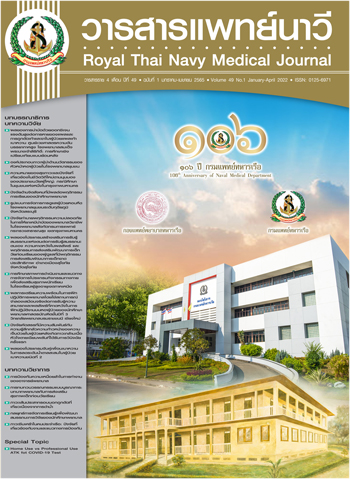Self-management Model for Asthma Patients of Secondary Community Hospitals in Saraburi Province
Main Article Content
Abstract
The objectives of this descriptive research were: 1) to analyze the self-management of asthma patients at secondary community hospitals in Saraburi province, 2) to develop a self-management model for asthma patients, and 3) to evaluate the appropriateness of the developed model. Samples were purposive sampling technique, consisted of 2 groups. The first were for analyzing the self-care management of asthma patients which comprised of 4 physicians, 4 professional nurses, 4 pharmacists, and 4 physical therapists, as well as 4 patients and 4 relatives. The second were for evaluating the appropriateness of the developed model, consisted of 2 health care providers, 2 patients and 3 experts. There were 2 sets of research instruments 1) A semi-structured interview for analyzing the self-management of asthma patients and health care providers which was divided into 2 parts. 2) The guideline for evaluating the appropriateness of the self-management developed model. Both instruments conducted content validity by 5 experts, and there were 0.78, 0.84, and 0.79, respectively. Data were analyzed by descriptive statistics and content analysis.
Findings indicated that, 1) Asthma patients had insufficient knowledge and abilities to manage their health for themselves. They needed more support from the roles of health care providers and their families as well as communities. 2) The self-management model for asthma patients consisted of 3 main dimensions, the roles of health care providers, the roles of patients’ families and communities, and the roles of asthma patients; as well as 7 sub-dimensions to enhance patients’ self-management that consisted of (1) providing continuous health services, and linking from hospitals to patients’ homes, (2) working as multidisciplinary teams, (3) developing patients’ care guidelines and guidelines for health education, (4) developing nurses’ competencies for case management, (5) developing the patients’ recording system and taking the results back to the patients, (6) promoting patents’ exercise, stress management, and effective drug use, and (7) participation from patients’ families and communities including developing the patients’ environments. Finally, 3) experts evaluated the self-management model for asthma patients as appropriate (84.53%).
Article Details

This work is licensed under a Creative Commons Attribution-NonCommercial-NoDerivatives 4.0 International License.
References
World Health Organization. Asthma. [Internet]. [cited 2021 January 11]. Available from: https://www.who.int/news-room/fact-sheets/detail/asthma.
Strategy and Planning Division, Ministry of Public Health. Public health statistics A.D. 2018. Nonthaburi: Strategy and Planning Division, Ministry of Public Health; 2019. (in Thai).
Boonpiyathat T, Yimsawad S, Sangasapaviriya A. The cost of asthma treatment in Phramongkutklao hospital: population-base study in adult. Journal of the Medical Association of Thailand 2016;99(1):51-7. (in Thai).
Niyomwit K. Nursing care for ill children with acute asthmatic attack. Journal of Phrapokklao Nursing College 2017;28(1):149-60. (in Thai).
Ruanglapanun W, Wichiencharoen K, Seeda R, Wannapong S. Impacts of asthma disease on school-age asthmatic children and family. J Nurs Sci 2009;27(2):18-27. (in Thai).
Chandondaeng P, Promasatayaprot V, Buranakongkatree U. Quality development system for the chronic care model in Nawa SHPH, Khemarat district, Ubon Ratchathani province. Mahasarakham Hospital Journal 2015;12(3):84-94. (in Thai).
Wagner EH. Chronic disease management: what will it take to improve care for chronic illness? Eff Clin Pract 1998;1(1):2-4.
Global Initiative for Asthma. Global strategy for asthma management and prevention: Updated 2019. [Internet]. [cited 2018 August 20]. Available from: https://ginasthma.org/2019-ginareport-global-strategy-for-asthma-management-and- prevention.
Boonsawat W. Introduction of easy asthma clinic. [Internet]. [cited 2019 October 10]. Available from: http://eac2.easyasthma.com/mdbtemplate/mytemplate/template.php?component=view_article&qid=4. (in Thai).
Creer TL. Self-management for chronic illness. [Internet]. [cited 2019 November 11]. Available from: http://cachescan.bcub.ro/e-book/E1/580704/601-649.pdf.
Brouwers MC, Kho ME, Browman GP, Burgers JS, Cluzeau F, Feder G, et al. AGREE II: advancing guideline development, reporting and evaluation in healthcare. CMAJ 2010;182:E839-42.
Bodhicita C. Science and art qualitative research. 8th ed. Bangkok: Amarin Printing and Publishing; 2019. (in Thai).
Machapamo P. Development of asthma patient care model through participation of health network in Wapipathum hospital, Mahasarakham. Journal of Health Science 2017;26(5):896-904. (in Thai).
Ton S. Clinical outcome of pediatric asthma at asthma clinic of Phimai hospital. Nakhon Racth Med Bull 2017;39(3):173-82. (in Thai).
Butarach K , Ruangklin C. Development of case management model for the care of person with asthma at Chiangyuen hospital, Mahasarakham province. Mahasarakham Hospital Journal 2016;13(1):18-27. (in Thai).
Wathanachaporn P. Asthma severity, family management behavior and asthma symptom control in children among family caregivers. Nursing Journal 2016;43(2):1-12. (in Thai).


